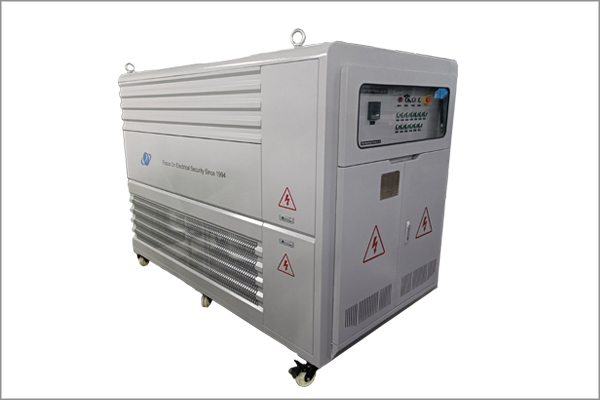Trends in Load Bank Technology Upgrades: How Intelligent and Modular Designs Are Transforming Industry Applications?
Time:2025-08-12
In the stable operation of industrial power systems, load banks, as key tools for simulating electrical loads and verifying equipment performance, have their technological development always closely linked to industry demands. With the increasing requirements for precision, efficiency, and flexibility in power testing in fields such as new energy, data centers, and shipbuilding, the limitations of traditional load banks in terms of operational complexity, functional adaptability, and maintenance costs have become increasingly prominent. Against this backdrop, intelligentization and modularization have emerged as the core directions for load bank technology upgrades, fundamentally changing the application patterns of the industry and injecting new vitality into the field of power testing.
Intelligent upgrades have endowed load banks with the capabilities of "perception, analysis, and decision-making", completely breaking the shackles of traditional equipment that relied on manual operation. Modern intelligent load banks generally integrate high-precision sensor networks, Internet of Things (IoT) communication modules, and edge computing units. They can real-time collect key parameters such as voltage, current, power, and temperature, and transmit data to cloud platforms or local monitoring systems through wireless or wired networks. With the help of data analysis algorithms, load banks can automatically generate test reports, identify abnormal working conditions, and even predict potential equipment failures. For example, in generator set testing, intelligent load banks can early warn of problems such as engine wear or oil circuit blockages by continuously monitoring fuel consumption, speed fluctuations, and emission data of the unit under different loads, realizing the transformation from "passive maintenance" to "predictive maintenance". In addition, intelligentization is also reflected in automated control. Operators can set load curves and start/stop test procedures through remote terminals, significantly reducing on-site operation time, which is especially suitable for testing scenarios in high-risk, high-altitude, or remote areas.
Modular design solves the pain points of traditional load banks, such as "high customization costs and difficult power expansion", from the hardware architecture level, providing unprecedented flexibility for industry applications. Modular load banks disassemble core functions into independent units such as standardized power modules, control modules, and cooling modules. Users can flexibly combine the number of modules according to testing needs, achieving seamless power expansion from tens of kilowatts to several megawatts. This design not only reduces equipment manufacturing and maintenance costs—when a single module fails, there is no need to shut down the entire system for replacement; instead, only the faulty unit needs to be replaced to resume operation—but also can quickly adapt to testing requirements of different scenarios. In new energy photovoltaic inverter testing, by matching different types of power modules, complex load characteristics such as resistive, inductive, and capacitive can be simulated. In data center UPS system testing, modular load banks can quickly switch between three-phase and single-phase output modes to meet redundancy testing requirements of different power levels. More importantly, modular design shortens the equipment delivery cycle. Traditional customized load banks may require several months of production time, while modular products can be delivered within a few weeks through standardized module combination, greatly improving the industry's response speed.
The in-depth integration of intelligentization and modularization is reshaping the application boundaries of load banks and promoting the upgrading of testing modes in multiple fields. In the new energy field, intelligent modular load banks have become the "performance examiners" for energy storage systems and photovoltaic power plants. By dynamically adjusting load power to simulate grid fluctuations and using intelligent algorithms to analyze core indicators such as charging and discharging efficiency and cycle life of energy storage batteries, they provide accurate data for battery selection and system optimization. In the shipbuilding industry, modular load banks can be flexibly combined according to the power level of ship generators, and cooperate with intelligent monitoring systems to realize dynamic load simulation under navigation conditions, verifying the stability of the ship's power system in extreme weather or when equipment load suddenly increases. In the data center field, intelligent load banks can link with data center management systems to real-time simulate load changes of server clusters, test the switching time, redundancy capability, and energy-saving mode of UPS systems, ensuring the uninterrupted operation of key equipment.
Looking forward to the future, the upgrading of load bank technology will further move towards "in-depth intelligentization" and "high modularization". In terms of intelligentization, the introduction of artificial intelligence (AI) algorithms will enable autonomous learning of test scenarios and intelligent generation of load curves, allowing load banks to more accurately simulate complex electrical environments. In terms of modularization, the research and development of cross-scenario universal modules will break industry barriers, enabling the same set of load bank systems to be flexibly applied in multiple links such as power generation, transmission, and electricity consumption. It can be said that intelligentization and modularization not only improve the technical performance of load banks but also promote the transformation of the entire power testing industry towards high efficiency, precision, and low cost, providing a solid guarantee for the safe and stable operation of the industrial field.
News Recommendation
-
 2024-09-11
2024-09-11TRIUMPH LOAD EXHIBITING AT Enlit Europe 2024 -BOOTH 7.H08
-
 2023-04-21
2023-04-21TRIUMPH LOAD EXHIBITING AT DATA CENTER WORLD GERMANY 2023-BOOTH F909
-
 2023-04-06
2023-04-06TRIUMPH LOAD EXHIBITING AT ELECTRIC POWER TECH KOREA 2023 – Booth G109
-
 2022-05-05
2022-05-05What is the role of ac load bank for power supply?
-
 2022-05-05
2022-05-05What is the role of the load bank?


